Experts studying the incredible Staffordshire Hoard have pieced together thousands of fragments to reveal a rare warrior's helmet and a unique sword pommel.
Archaeologists working with the hoard - the largest collection of Anglo-Saxon artefacts ever found - said the two examples of 7th century 'warrior splendour' were likely made in workshops set up by some of England's earliest kings.
The silver helmet is not yet completely constructed but includes ear pieces, most of the cap and the crest.
And its band reveals etchings of animals and kneeling Saxon warriors, while other parts show men with handlebar moustaches.
The Staffordshire Hoard was found by metal detectorist Terry Herbert in a farmer's field near the village of Hammerwich in July 2009 and is worth around £3.3 million. It includes 500 pieces such as gold sword hilts, jewels from Sri Lanka and early Christian crosses.
Anglo-Saxon England was the richest and most advanced society in Europe.
Secrets of the golden hoard: Experts piece warrior's helmet and sword back together to unlock life in the Dark Ages
Helmet was likely made in workshops set up by England's earliest kings
Archaeologists say only five Anglo-Saxon helmets are known in Britain
They also pieced together a unique 7th century sword pommel from hoard
1,300-year-old treasure found using metal detector in Staffordshire in 2009
By Sarah Griffiths and Steph Cockroft for MailOnline
26 May 2015
Daily Mail
Experts studying the incredible Staffordshire Hoard have pieced together thousands of fragments to reveal a rare warrior's helmet and a unique sword pommel.
Archaeologists working with the hoard - the largest collection of Anglo-Saxon artefacts ever found - said the two examples of 7th century 'warrior splendour' were likely made in workshops set up by some of England's earliest kings.
The silver helmet is not yet completely constructed but includes ear pieces, most of the cap and the crest.
And its band reveals etchings of animals and kneeling Saxon warriors, while other parts show men with handlebar moustaches.
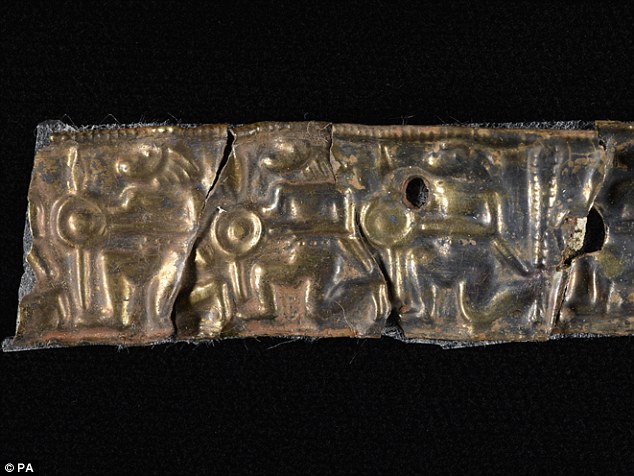
Experts studying the incredible Staffordshire Hoard have uncovered a rare warrior's helmet, which includes this helmet band, by piecing together thousands of minuscule scraps of precious metal. The treasure - the largest collection of Anglo-Saxon artefacts ever found - dates from between 675 and 725AD, the time of Beowulf: the great Anglo-Saxon poem and the first great piece of literature written in the English language
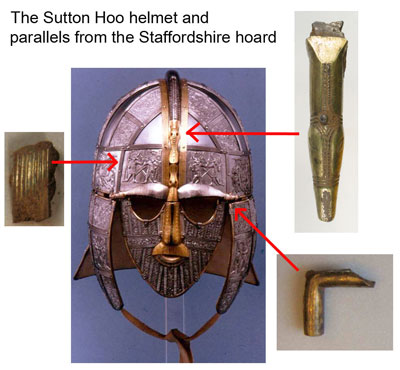
The Staffordshire Anglo-Saxon helmet has many similarities to the one found at Sutton Hoo in Suffolk in 1939
Anglo-Saxon helmets are incredibly rare in Britain and this is only the fifth to be discovered.
Experts worked for three solid days to reassemble some 1,500 thin, fragile silver sheets into parts of the helmet band and other details.
The painstaking job saw these fragments - many measuring less than one centimetre across and making up around a third of the Hoard in size - pieced together to reveal intricate, die-stamped designs, including on the helmet band, which ran around the circumference of the helmet.
Pieta Greaves, who is in charge of the research for the hoard, told MailOnline that the detailed band would have been level with the wearer's ears.
The remarkable designs depict kneeling human warriors around the band as well as fragments showing male moustachioed faces, birds, animals and mythical beasts.
But experts have yet to tie them to the helmet.
Some of the warriors depicted have handlebar moustaches, which may hint that the style was fashionable at the time.
She told The Times: 'I don't known what [the find] will tell us about fashion of the period.
'Perhaps being able to groom yourself indicates being part of an elite -they're quite long moustaches, quite handle-bar like.'
Other depictions of warriors on other artefacts are clean shaven or have shaggy beards, suggesting that just like today, men may simply have chosen whether they had a beard or not depending on their personal preferences.
But Dr Greaves said it's possible the images are of ancestral or idealised warriors, intended to give spiritual support to the wearer.
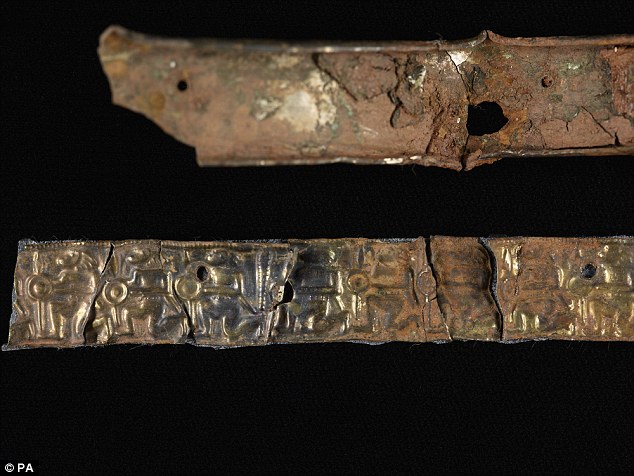
The helmetband, depicting a frieze of warriors (pictured), is part of the incredibly rare silver helmet which is among just five previously known in Britain

Some of the warriors depicted show Anglo Saxon warriors with handlebar moustaches. It may hint that the style was fashionable at the time. Experts are unsure if this piece is from the helmet or not
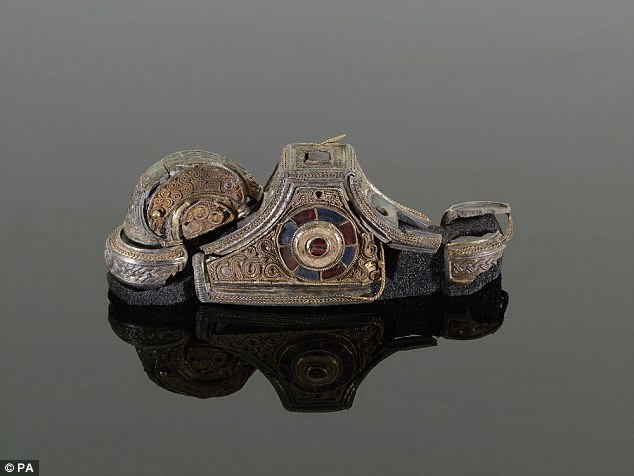
Researchers have also uncovered a unique sword pommel made up of gold, silver, garnet, glass and deliberately blackened silver niello work (pictured)
She explained that similar men with handlebar moustaches are known on other Anglo Saxon objects such as a drinking horn from Sutton Hoo, suggesting they could have been used to represent an ancestor or figure from a legend.
'The helmet obviously belonged to someone of huge importance, such as a king,' she said.

The designs depict kneeling human warriors around the band (pictured) as well as fragments showing male moustachioed faces, birds, animals and mythical beasts. Another part of the helmet is shown above

There are more than 70 pommels in the hoard, but the newly constructed artefact has been described as ‘exceptional’ and is the first of its kind to be found. This is the back of the pommel
HOARD RESEARCH - WHAT THE EXAMINATION OF THE ARTEFACTS REVEALED
The number of artefacts in the collection now stands at 4,000, after more than the first 500 objects found were revealed in nearby fields - including a garnet bird mount.
Many broken fragments have been joined together into their original objects such as new types of sword fittings and other mounts.
Groups of sword fittings have been matched to show what original sword hilts looked like.
At least one helmet, composed of over 1,500 pieces, is contained in the treasure. Anglo-Saxon helmets are incredibly rare in Britain - only five were previously known.
The sword and weaponry fittings show for the first time the true extent of the gold wealth and aspirations of the ruling warrior class of early England. Previously, only glimpses of these warriors had been revealed in exceptional burials like Sutton Hoo.
The analysis has revealed much new information about how the objects were constructed including: the composition of the alloys used, the joining of metal with woods and animal horn plus the glues and resins made of animal and plant extracts.
A variety of types of Saxon and re-used Roman glass has also been identified.
They also reassembled a pommel - the part of the sword that fits at the end of a sword-grip - made up of gold, silver, garnet, glass and deliberately blackened silver niello work, which is a black inlay formed from copper, silver, and lead sulphides.
Experts say the find suggests the coming together of Anglo-Saxon and British or Irish high cultures.
Chris Fern, project archaeologist, said: 'The gold and silver war-gear was probably made in workshops controlled by some of England's earliest kings to reward warriors that served those rulers, when multiple kingdoms fought for supremacy.
'The skill of the craftsmen is equally thrilling to behold, with many of the finds decorated with pagan and Christian art, designed to give spiritual protection in battle.
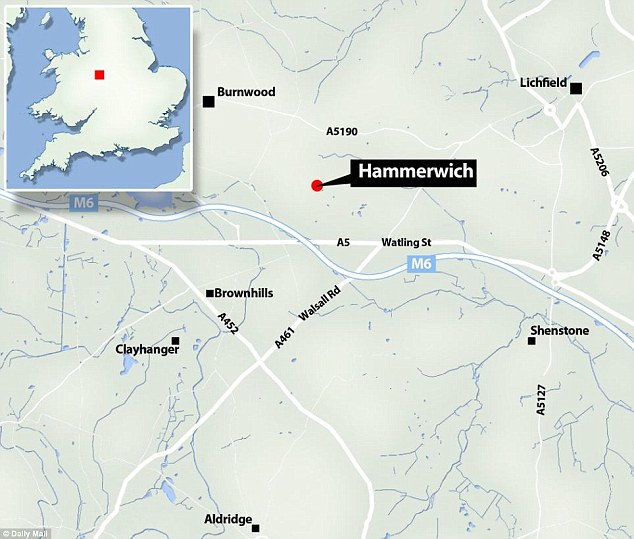
The hoard was discovered near the Staffordshire village of Hammerwich (pictured) in a farmer's field next to the A5 in July 2009 by treasure hunter Terry Herbert. A second batch was found nearby in November 2012
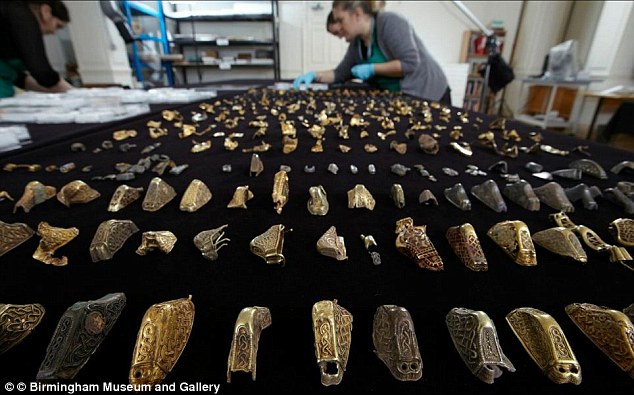
Last year, 4,000 pieces of the Staffordshire Hoard were been brought back together for the first time, allowing experts (pictured) to shed some light on life in the dark ages. They recently finished cleaning the artefacts, which range from fragments of helmet to gold sword decorations


The skills of the ancient jewellers are easily apparent with threads of gold less than a millimetre thick wound into intricate shapes (shown left), and tiny pieces of red and blue garnet stone that have been carved into elaborate, curved shapes to fit into decorations (right)
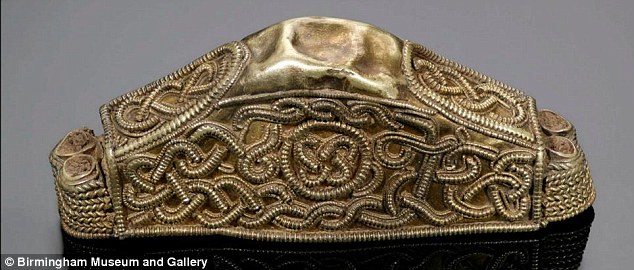
The experts previously revealed that the vast majority of the Hoard would have been owned or used by soldiers, showing that it was not just kings who went into battle with their weaponry and armour decorated with gold and intricate jewellery. An example is shown

At the time it was hidden, Staffordshire was the heartland of Mercia, an aggressive kingdom. The gold could have been collected during wars with the kingdoms of Northumbria and East Anglia
THE DISCOVERY OF THE HOARD

A treasure hunter made the find in 2009.
It was the most valuable hoard of Saxon gold in history - estimated to be worth £3.3million ($5 million) - and includes 500 pieces such as gold sword hilts, jewels from Sri Lanka and early Christian crosses.
The 1,300-year-old treasure was discovered by unemployed Terry Herbert in July in a field owned by a friend in Staffordshire.
Within days, the 55-year-old former coffin factory worker from Walsall had filled 244 bags with gold objects weighing in at more than 11lbs (5kg).
Mr Herbert, who bought an old metal detector for £2.50 18 years ago, said he was overwhelmed by the find – regarded as one of the most important in decades.
‘I have this phrase that I say sometimes – “spirits of yesteryear take me where the coins appear” – but on that day I changed coins to gold,’ he said.
‘I don’t know why I said it that day, but I think somebody was listening and directed me to it. Maybe it was meant to be, maybe the gold had my name on it all along.
‘I was going to bed and in my sleep I was seeing gold items.’
The jewels are thought to have come from Sri Lanka - carried to Europe by traders.
The gold probably came from the Byzantine Empire, the eastern remnant of the Roman Empire based in what is now Istanbul.
The treasure dates from between 675 and 725AD, the time of Beowulf – the great Anglo-Saxon poem.
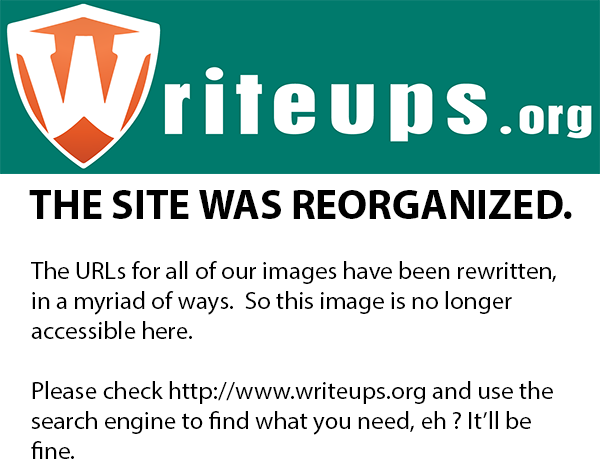
The treasure dates from around the time of Beowulf, the first great piece of English literature
THE PRECIOUS POMMEL
There are more than 70 pommels in the hoard, but the newly constructed artefact has been described as ‘exceptional’ and is the first of its kind to be found.
It was reformed from 26 pieces and while Anglo-Saxon in Style, it has British or Irish art influences.
Its central garnet and glass inlaid disc can be seen to form an early Christian cross and on the other side is a motif formed of three serpents, representing both Christian and pagan beliefs.
Most unusual is the rounded hump on the pommel’s shoulder, known as a ‘sword-ring’ – there would have been two originally, one on each shoulder.
Many swords from this period in England and Europe have such rings, but the hoard pommel is the first to have had two.
This, with its lavish ornament, points to it possibly belonging to an individual of significant status.
'The newly recognised pommel is truly exciting. It combines multiple different styles of ornament, much in the same way as the earliest 7th century illuminated manuscripts do, like the Book of Durrow.'
The 1,300-year-old treasure - which includes up to 4,000 pieces - was discovered by unemployed Terry Herbert in July 2010 in a field owned by a friend in Staffordshire.
Another 90 pieces were recovered from the same field three years later.
The haul includes gold, silver and some copper alloy objects as well as beautiful gold sword hilts, jewels from Sri Lanka, exquisitely carved helmet decorations and early Christian crosses.
In total the hoard includes more than 11lb (5kg) of gold, 3.3lbs (1.5kg) of silver and thousands of small garnets.
It was valued at £3.3 million ($5 million) by independent experts at the British Museum - the most valuable treasure discovery ever made.
Historic England has so far allocated £400,000 ($616,000) to help conserve the hoard, including work to clean the silver, gold and garnet objects and fragments.
Birmingham City Council and Stoke-on-Trent City Council, which jointly own the hoard, now aim to raise £120,000 for further work to assemble more artefacts from individual pieces of metalwork.
The sword and weaponry fittings have shown for the first time the true extent of the gold wealth and aspirations of the ruling warrior class of early England.
The analysis has also revealed much new information about how the objects were constructed including the composition of the alloys used.
Duncan Wilson, Historic England's chief executive, said: 'Since its discovery, the Staffordshire Hoard and the stories behind it have captured the public imagination.
'As technology and research methods develop we are able to discover more and more, and share the results, but more money needs to be raised to capitalise fully on this rich potential.'
Both the items have now been put on display at Birmingham's Museum and Art Gallery.
Members of the public can make donations to the conservation work here.

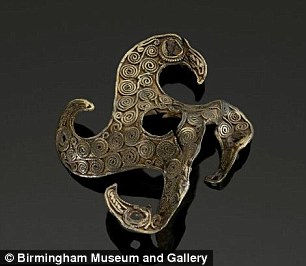
There is evidence of Christian and pagan beliefs in the Hoard. These two artefacts, pictured left and right, are examples of early Christian crosses

At the time it was hidden, Staffordshire was the heartland of Mercia, an aggressive kingdom. The gold could have been collected during wars with the kingdoms of Northumbria and East Anglia. Some appears to have been deliberately removed from the objects to which they were attached and twisted (shown)
Archaeologists working with the hoard - the largest collection of Anglo-Saxon artefacts ever found - said the two examples of 7th century 'warrior splendour' were likely made in workshops set up by some of England's earliest kings.
The silver helmet is not yet completely constructed but includes ear pieces, most of the cap and the crest.
And its band reveals etchings of animals and kneeling Saxon warriors, while other parts show men with handlebar moustaches.
The Staffordshire Hoard was found by metal detectorist Terry Herbert in a farmer's field near the village of Hammerwich in July 2009 and is worth around £3.3 million. It includes 500 pieces such as gold sword hilts, jewels from Sri Lanka and early Christian crosses.
Anglo-Saxon England was the richest and most advanced society in Europe.
Secrets of the golden hoard: Experts piece warrior's helmet and sword back together to unlock life in the Dark Ages
Helmet was likely made in workshops set up by England's earliest kings
Archaeologists say only five Anglo-Saxon helmets are known in Britain
They also pieced together a unique 7th century sword pommel from hoard
1,300-year-old treasure found using metal detector in Staffordshire in 2009
By Sarah Griffiths and Steph Cockroft for MailOnline
26 May 2015
Daily Mail
Experts studying the incredible Staffordshire Hoard have pieced together thousands of fragments to reveal a rare warrior's helmet and a unique sword pommel.
Archaeologists working with the hoard - the largest collection of Anglo-Saxon artefacts ever found - said the two examples of 7th century 'warrior splendour' were likely made in workshops set up by some of England's earliest kings.
The silver helmet is not yet completely constructed but includes ear pieces, most of the cap and the crest.
And its band reveals etchings of animals and kneeling Saxon warriors, while other parts show men with handlebar moustaches.

Experts studying the incredible Staffordshire Hoard have uncovered a rare warrior's helmet, which includes this helmet band, by piecing together thousands of minuscule scraps of precious metal. The treasure - the largest collection of Anglo-Saxon artefacts ever found - dates from between 675 and 725AD, the time of Beowulf: the great Anglo-Saxon poem and the first great piece of literature written in the English language

The Staffordshire Anglo-Saxon helmet has many similarities to the one found at Sutton Hoo in Suffolk in 1939
Anglo-Saxon helmets are incredibly rare in Britain and this is only the fifth to be discovered.
Experts worked for three solid days to reassemble some 1,500 thin, fragile silver sheets into parts of the helmet band and other details.
The painstaking job saw these fragments - many measuring less than one centimetre across and making up around a third of the Hoard in size - pieced together to reveal intricate, die-stamped designs, including on the helmet band, which ran around the circumference of the helmet.
Pieta Greaves, who is in charge of the research for the hoard, told MailOnline that the detailed band would have been level with the wearer's ears.
The remarkable designs depict kneeling human warriors around the band as well as fragments showing male moustachioed faces, birds, animals and mythical beasts.
But experts have yet to tie them to the helmet.
Some of the warriors depicted have handlebar moustaches, which may hint that the style was fashionable at the time.
She told The Times: 'I don't known what [the find] will tell us about fashion of the period.
'Perhaps being able to groom yourself indicates being part of an elite -they're quite long moustaches, quite handle-bar like.'
Other depictions of warriors on other artefacts are clean shaven or have shaggy beards, suggesting that just like today, men may simply have chosen whether they had a beard or not depending on their personal preferences.
But Dr Greaves said it's possible the images are of ancestral or idealised warriors, intended to give spiritual support to the wearer.

The helmetband, depicting a frieze of warriors (pictured), is part of the incredibly rare silver helmet which is among just five previously known in Britain

Some of the warriors depicted show Anglo Saxon warriors with handlebar moustaches. It may hint that the style was fashionable at the time. Experts are unsure if this piece is from the helmet or not

Researchers have also uncovered a unique sword pommel made up of gold, silver, garnet, glass and deliberately blackened silver niello work (pictured)
She explained that similar men with handlebar moustaches are known on other Anglo Saxon objects such as a drinking horn from Sutton Hoo, suggesting they could have been used to represent an ancestor or figure from a legend.
'The helmet obviously belonged to someone of huge importance, such as a king,' she said.

The designs depict kneeling human warriors around the band (pictured) as well as fragments showing male moustachioed faces, birds, animals and mythical beasts. Another part of the helmet is shown above

There are more than 70 pommels in the hoard, but the newly constructed artefact has been described as ‘exceptional’ and is the first of its kind to be found. This is the back of the pommel
HOARD RESEARCH - WHAT THE EXAMINATION OF THE ARTEFACTS REVEALED
The number of artefacts in the collection now stands at 4,000, after more than the first 500 objects found were revealed in nearby fields - including a garnet bird mount.
Many broken fragments have been joined together into their original objects such as new types of sword fittings and other mounts.
Groups of sword fittings have been matched to show what original sword hilts looked like.
At least one helmet, composed of over 1,500 pieces, is contained in the treasure. Anglo-Saxon helmets are incredibly rare in Britain - only five were previously known.
The sword and weaponry fittings show for the first time the true extent of the gold wealth and aspirations of the ruling warrior class of early England. Previously, only glimpses of these warriors had been revealed in exceptional burials like Sutton Hoo.
The analysis has revealed much new information about how the objects were constructed including: the composition of the alloys used, the joining of metal with woods and animal horn plus the glues and resins made of animal and plant extracts.
A variety of types of Saxon and re-used Roman glass has also been identified.
They also reassembled a pommel - the part of the sword that fits at the end of a sword-grip - made up of gold, silver, garnet, glass and deliberately blackened silver niello work, which is a black inlay formed from copper, silver, and lead sulphides.
Experts say the find suggests the coming together of Anglo-Saxon and British or Irish high cultures.
Chris Fern, project archaeologist, said: 'The gold and silver war-gear was probably made in workshops controlled by some of England's earliest kings to reward warriors that served those rulers, when multiple kingdoms fought for supremacy.
'The skill of the craftsmen is equally thrilling to behold, with many of the finds decorated with pagan and Christian art, designed to give spiritual protection in battle.

The hoard was discovered near the Staffordshire village of Hammerwich (pictured) in a farmer's field next to the A5 in July 2009 by treasure hunter Terry Herbert. A second batch was found nearby in November 2012

Last year, 4,000 pieces of the Staffordshire Hoard were been brought back together for the first time, allowing experts (pictured) to shed some light on life in the dark ages. They recently finished cleaning the artefacts, which range from fragments of helmet to gold sword decorations


The skills of the ancient jewellers are easily apparent with threads of gold less than a millimetre thick wound into intricate shapes (shown left), and tiny pieces of red and blue garnet stone that have been carved into elaborate, curved shapes to fit into decorations (right)

The experts previously revealed that the vast majority of the Hoard would have been owned or used by soldiers, showing that it was not just kings who went into battle with their weaponry and armour decorated with gold and intricate jewellery. An example is shown

At the time it was hidden, Staffordshire was the heartland of Mercia, an aggressive kingdom. The gold could have been collected during wars with the kingdoms of Northumbria and East Anglia
THE DISCOVERY OF THE HOARD

A treasure hunter made the find in 2009.
It was the most valuable hoard of Saxon gold in history - estimated to be worth £3.3million ($5 million) - and includes 500 pieces such as gold sword hilts, jewels from Sri Lanka and early Christian crosses.
The 1,300-year-old treasure was discovered by unemployed Terry Herbert in July in a field owned by a friend in Staffordshire.
Within days, the 55-year-old former coffin factory worker from Walsall had filled 244 bags with gold objects weighing in at more than 11lbs (5kg).
Mr Herbert, who bought an old metal detector for £2.50 18 years ago, said he was overwhelmed by the find – regarded as one of the most important in decades.
‘I have this phrase that I say sometimes – “spirits of yesteryear take me where the coins appear” – but on that day I changed coins to gold,’ he said.
‘I don’t know why I said it that day, but I think somebody was listening and directed me to it. Maybe it was meant to be, maybe the gold had my name on it all along.
‘I was going to bed and in my sleep I was seeing gold items.’
The jewels are thought to have come from Sri Lanka - carried to Europe by traders.
The gold probably came from the Byzantine Empire, the eastern remnant of the Roman Empire based in what is now Istanbul.
The treasure dates from between 675 and 725AD, the time of Beowulf – the great Anglo-Saxon poem.

The treasure dates from around the time of Beowulf, the first great piece of English literature
THE PRECIOUS POMMEL
There are more than 70 pommels in the hoard, but the newly constructed artefact has been described as ‘exceptional’ and is the first of its kind to be found.
It was reformed from 26 pieces and while Anglo-Saxon in Style, it has British or Irish art influences.
Its central garnet and glass inlaid disc can be seen to form an early Christian cross and on the other side is a motif formed of three serpents, representing both Christian and pagan beliefs.
Most unusual is the rounded hump on the pommel’s shoulder, known as a ‘sword-ring’ – there would have been two originally, one on each shoulder.
Many swords from this period in England and Europe have such rings, but the hoard pommel is the first to have had two.
This, with its lavish ornament, points to it possibly belonging to an individual of significant status.
'The newly recognised pommel is truly exciting. It combines multiple different styles of ornament, much in the same way as the earliest 7th century illuminated manuscripts do, like the Book of Durrow.'
The 1,300-year-old treasure - which includes up to 4,000 pieces - was discovered by unemployed Terry Herbert in July 2010 in a field owned by a friend in Staffordshire.
Another 90 pieces were recovered from the same field three years later.
The haul includes gold, silver and some copper alloy objects as well as beautiful gold sword hilts, jewels from Sri Lanka, exquisitely carved helmet decorations and early Christian crosses.
In total the hoard includes more than 11lb (5kg) of gold, 3.3lbs (1.5kg) of silver and thousands of small garnets.
It was valued at £3.3 million ($5 million) by independent experts at the British Museum - the most valuable treasure discovery ever made.
Historic England has so far allocated £400,000 ($616,000) to help conserve the hoard, including work to clean the silver, gold and garnet objects and fragments.
Birmingham City Council and Stoke-on-Trent City Council, which jointly own the hoard, now aim to raise £120,000 for further work to assemble more artefacts from individual pieces of metalwork.
The sword and weaponry fittings have shown for the first time the true extent of the gold wealth and aspirations of the ruling warrior class of early England.
The analysis has also revealed much new information about how the objects were constructed including the composition of the alloys used.
Duncan Wilson, Historic England's chief executive, said: 'Since its discovery, the Staffordshire Hoard and the stories behind it have captured the public imagination.
'As technology and research methods develop we are able to discover more and more, and share the results, but more money needs to be raised to capitalise fully on this rich potential.'
Both the items have now been put on display at Birmingham's Museum and Art Gallery.
Members of the public can make donations to the conservation work here.


There is evidence of Christian and pagan beliefs in the Hoard. These two artefacts, pictured left and right, are examples of early Christian crosses

At the time it was hidden, Staffordshire was the heartland of Mercia, an aggressive kingdom. The gold could have been collected during wars with the kingdoms of Northumbria and East Anglia. Some appears to have been deliberately removed from the objects to which they were attached and twisted (shown)
Last edited:
